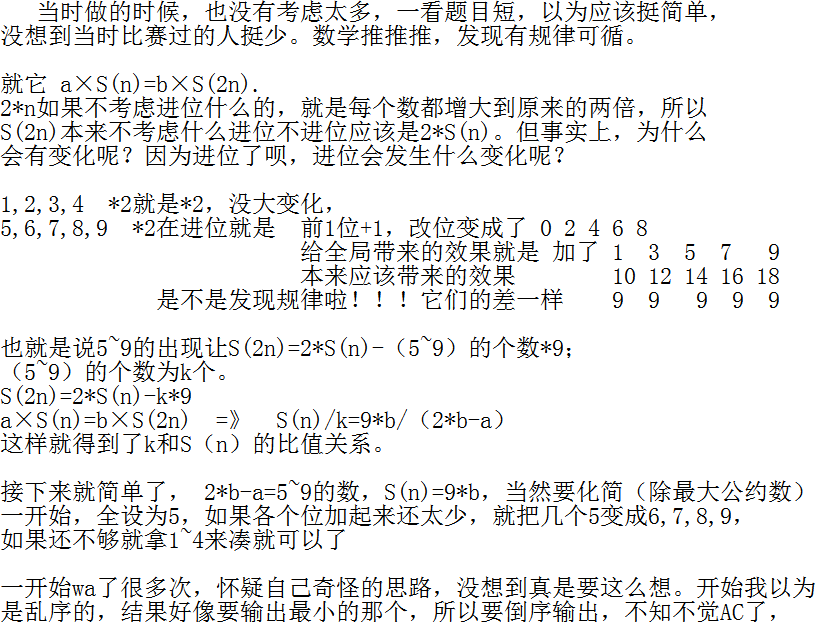哈哈哈封面图是题目描述里面的。本场比赛是HDU女生专场的clone。
HDU - 5702
一次ACM中打气球的志愿者们比较蠢,某一道题提前打好的气球越多,意味着题目越水。
直接开个结构体排序就好了。结果我一直PE,因为题目中说了不能有多余的空格,但是删掉所有多余的空格了还是不行,到最后都没有过。最后发现,必须要有多余的空行(什么鬼破题)
1 2 3 4 5 6 7 8 9 10 11 12 13 14 15 16 17 18 19 20 21 22 23 24 25 26 27 28 29 #include < cstdio > #include < cstring > #include < algorithm > using namespace std ;const int maxn=200005 ;struct node { char str[15 ]; int x; } a[maxn]; int T,n;bool cmp (node a,node b) return a.x>b.x;}int main () scanf ("%d" ,&T); while (T--) { scanf ("%d" ,&n); for (int i=1 ;i<=n;i++) scanf ("%s%d" ,a[i].str,&a[i].x); sort(a+1 ,a+n+1 ,cmp); for (int i=1 ;i<=n;i++) { if (i==n) printf ("%s" ,a[i].str); else printf ("%s " ,a[i].str); } printf ("\n" ); } return 0 ; }
HDU - 5704
n(2~100)个人参加一个游戏,
现在,我们也参加比赛,其他n-1个人所选择的数也已经确定了,并且我们知道。
直接枚举每一种情况,取最大值就好。
1 2 3 4 5 6 7 8 9 10 11 12 13 14 15 16 17 18 19 20 21 22 23 24 25 26 27 28 29 30 31 #include < cstdio > #include < cstring > #include < algorithm > using namespace std ;const int maxn=200005 ;int T,n,a[maxn],cnt[maxn];int main () scanf ("%d" ,&T); while (T--) { memset (cnt,0 ,sizeof (cnt)); int sum=0 ,maxx=0 ; scanf ("%d" ,&n); for (int i=1 ;i<n;i++) { scanf ("%d" ,&a[i]); sum+=a[i]; cnt[a[i]]++; } for (int i=0 ;i<=100 ;i++) { double k=(double )sum+(double )i; k/=(double )n; double m=k*2.0 /3.0 ; if (i<=floor (m)) maxx=floor (m); } printf ("%d %.2lf\n" ,maxx,1.0 /(cnt[maxx]+1.0 )); } return 0 ; }
HDU - 5706
给一个n*m的由小写字母组成的字符地图,从某个点开始,每次沿着相邻的点走,如果从起点开始计数,连着走4步并且构成“girl”,那么girl数++;如果连着走3步并且构成“cat”,那么cat数++。请问图上有多少个girl和多少只cat。
把每一个点作为起点开始搜索,直接dfs或bfs即可。这道题又吃了看错题意的亏……
1 2 3 4 5 6 7 8 9 10 11 12 13 14 15 16 17 18 19 20 21 22 23 24 25 26 27 28 29 30 31 32 33 34 35 36 37 38 39 40 41 42 43 44 45 46 47 48 49 50 51 52 53 54 55 56 57 #include < cstdio > #include < cstring > #include < algorithm > using namespace std ;const int maxn=2005 ;char str[maxn][maxn];int dx[5 ]={0 ,0 ,0 ,1 ,-1 };int dy[5 ]={0 ,1 ,-1 ,0 ,0 };int n,m,T;long long cat,girl;void dfs1 (int x,int y,int cnt) if (cnt==4 ) { girl++; return ; } for (int i=1 ;i<=4 ;i++) { int ddx=dx[i]+x,ddy=dy[i]+y; if (cnt==1 &&str[ddx][ddy]=='i' ) dfs1(ddx,ddy,cnt+1 ); if (cnt==2 &&str[ddx][ddy]=='r' ) dfs1(ddx,ddy,cnt+1 ); if (cnt==3 &&str[ddx][ddy]=='l' ) dfs1(ddx,ddy,cnt+1 ); } } void dfs2 (int x,int y,int cnt) if (cnt==3 ) { cat++; return ; } for (int i=1 ;i<=4 ;i++) { int ddx=dx[i]+x,ddy=dy[i]+y; if (cnt==1 &&str[ddx][ddy]=='a' ) dfs2(ddx,ddy,cnt+1 ); if (cnt==2 &&str[ddx][ddy]=='t' ) dfs2(ddx,ddy,cnt+1 ); } } int main () scanf ("%d" ,&T); while (T--) { scanf ("%d%d" ,&n,&m);cat=girl=0 ; memset (str,0 ,sizeof (str)); for (int i=1 ;i<=n;i++) scanf ("%s" ,str[i]+1 ); for (int i=1 ;i<=n;i++) for (int j=1 ;j<=m;j++) { if (str[i][j]=='g' ) dfs1(i,j,1 ); if (str[i][j]=='c' ) dfs2(i,j,1 ); } printf ("%lld %lld\n" ,girl,cat); } return 0 ; }
HDU - 5710
令s(n)为n的各位数之和,如n=12345时,s(n)=1+2+3+4+5=15。现在给定a,b,求找出最小的正整数n满足
a × s ( n ) = = b × s ( 2 ⋅ n ) ( 1 ≤ a , b ≤ 100 ) a\times s(n)==b\times s(2\cdot n)\;(1\leq a,b\leq100)
a × s ( n ) = = b × s ( 2 ⋅ n ) ( 1 ≤ a , b ≤ 1 0 0 )
转自:qq_40875849
HDU - 2670
有n个男生追一个女生,每个男生有一个相应的爱慕值Vx(i),给定一个天数m,每天这个女生只能找一个女生,并且得到这个男生的爱慕值。每过一天,每个男生的爱慕值就会减少相应的 Vy(i);问女生如何选择,m天之后,才能得到最大的爱慕值。
好像是经典的背包问题,感觉很早很早之前做过。
1 2 3 4 5 6 7 8 9 10 11 12 13 14 15 16 17 18 19 20 21 22 23 #include < cstdio > #include < cstring > #include < algorithm > using namespace std ;const int maxn=2005 ;int f[maxn],n,k;struct node {int love,cost;} stu[maxn];bool cmp (node a,node b) return a.cost>b.cost;}int main () while (~scanf ("%d%d" ,&n,&k)) { for (int i=1 ;i<=n;i++) scanf ("%d" ,&stu[i].love); for (int i=1 ;i<=n;i++) scanf ("%d" ,&stu[i].cost); sort(stu+1 ,stu+n+1 ,cmp); memset (f,0 ,sizeof (f)); for (int i=1 ;i<=n;i++) for (int j=k;j;j--) f[j]=max(f[j],f[j-1 ]+stu[i].love-stu[i].cost*(j-1 )); printf ("%d\n" ,f[k]); } return 0 ; }
HDU - 2674
C a l c u l a t e N ! m o d 2009 ( 0 ≤ N ≤ 1 0 9 ) H i n t : 0 ! = 1 , N ! = N × ( N − 1 ) ! Calculate\;N!\;mod\;2009\;(0\leq N\leq10^9)\\Hint\;:\;0!\;=\;1,\;N!\;=\;N\times(N-1)!
C a l c u l a t e N ! m o d 2 0 0 9 ( 0 ≤ N ≤ 1 0 9 ) H i n t : 0 ! = 1 , N ! = N × ( N − 1 ) !
显然2009的倍数mod上2009等于0,那么当计算到2009的阶乘时,答案就已经为0了,而0乘任何数都等于0,所以当N > 2009时,直接输出0就好了。
1 2 3 4 5 6 7 8 9 10 11 12 13 14 15 16 17 18 19 20 21 22 #include < cstdio > #include < cstring > #include < algorithm > using namespace std ;const int maxn=200005 ;unsigned long long fac[maxn];int n;int main () fac[0 ]=fac[1 ]=1 ; for (unsigned long long i=2 ;i<maxn;i++) { fac[i]=i*fac[i-1 ]; fac[i]%=2009 ; } while (~scanf ("%d" ,&n)) { if (n>=2009 ) printf ("0\n" ); else printf ("%llu\n" ,fac[n]); } return 0 ; }
HDU - 2672
GDJIJ,EL SSJT UT YWOSQNIVZMI. -> HELLO,MY NAME IS LINDAINVERS.
输入一个字符串,根据以上规律解码后输出。
什么条件都没给,肯定和字符串字母变换直接有关。先写了一个打表程序,看了一下解码串与原串的ascii码差,发现是斐波拉契数列。于是,直接模拟就好了,注意空格和非大写字母字符不转码。
1 2 3 4 5 6 7 8 9 10 11 12 13 14 15 16 17 18 19 20 21 22 23 24 25 26 27 28 29 30 31 #include < cstdio > #include < cstring > #include < algorithm > #include < string > #include < iostream > using namespace std ;const int maxn=200005 ;unsigned long long a[maxn];int main () string s; a[1 ]=1 ;a[2 ]=1 ; for (int i=3 ;i<maxn;i++) a[i]=a[i-1 ]+a[i-2 ],a[i]%=26 ; while (getline(cin ,s)) { int len=s.length(),cnt=1 ; for (int i=0 ;i<len;i++) { if (s[i]<'A' ||s[i]>'Z' ) cout <<s[i]; else { s[i]='A' +(s[i]+a[cnt]-'A' )%26 ; cout <<s[i]; cnt++; } } cout <<endl ; s.clear(); } return 0 ; }
HDU - 5707
给定a,b,c三个串,问c能否按序分成a和b串,不要求连续。
首先想到扫两遍,但这样会有问题,因为比如aaa,daf,adafaa,就会发现第一遍扫的时候,占用了前面的一个a,导致了第二遍匹配失败。
1 2 3 4 5 6 7 8 9 10 11 12 13 14 15 16 17 18 19 20 21 22 23 24 25 26 27 28 29 30 31 32 33 34 35 36 37 38 39 40 #include < cstdio > #include < cstring > #include < algorithm > using namespace std ;const int maxn=2005 ;char s1[maxn],s2[maxn],s3[maxn];int cnt[maxn],cnt2[maxn];bool vis[maxn],f[maxn][maxn];int main () while (~scanf ("%s%s%s" ,s2+1 ,s3+1 ,s1+1 )) { memset (cnt,0 ,sizeof (cnt)); memset (cnt2,0 ,sizeof (cnt2)); memset (vis,true ,sizeof (vis)); memset (f,false ,sizeof (f)); bool flag=true ; int l1=strlen (s1+1 ),l2=strlen (s2+1 ),l3=strlen (s3+1 ); for (int i=1 ;i<=l1;i++) cnt[s1[i]]++; for (int i=1 ;i<=l2;i++) cnt2[s2[i]]++; for (int i=1 ;i<=l3;i++) cnt2[s3[i]]++; for (int i=0 ;i<maxn;i++) if (cnt[i]!=cnt2[i]) flag=false ; f[0 ][0 ]=true ; for (int i=0 ;i<=l2;i++) { for (int j=0 ;j<=l3;j++) { if (i&&f[i-1 ][j]&&s2[i]==s1[i+j]) f[i][j]=true ; if (j&&f[i][j-1 ]&&s3[j]==s1[i+j]) f[i][j]=true ; } } if (l2+l3!=l1) flag=false ; if (!f[l2][l3]) flag=false ; if (flag) printf ("Yes\n" ); else printf ("No\n" ); } return 0 ; }
难度不大,但是那个PE真的把我坑惨了……以后要多试试,因为你根本不知道出题人想让你干什么。









